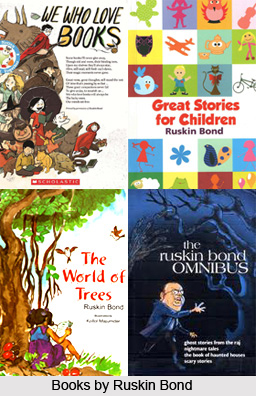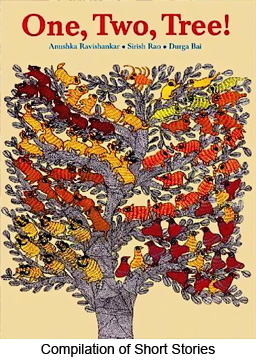"But trailing clouds of Glory do we come
From God, who is our home:
Heaven lies about us in our infancy!"
 The above mentioned quote from William Wordsworth`s "Ode, Intimations of Immortality from Recollections of Early Childhood", perhaps excellently illustrates what many of the current adult Indian population might just feel about the world of childhood and being a child. The contemporary approach towards children`s literature in India is in many times, coloured by such similar attitudes. Children`s literature in India has forever clung to this romantic image of childhood.
The above mentioned quote from William Wordsworth`s "Ode, Intimations of Immortality from Recollections of Early Childhood", perhaps excellently illustrates what many of the current adult Indian population might just feel about the world of childhood and being a child. The contemporary approach towards children`s literature in India is in many times, coloured by such similar attitudes. Children`s literature in India has forever clung to this romantic image of childhood.
Children`s literature in India is meant for readers and listeners up to approximately twelve years of age and is often exemplified with detailed illustrations. The term is utilised in senses which at times can also exclude young-adult fiction, comic books, or other genres. It is also a known fact that books specifically written for children did begin to exist by the 17th century. Scholarship on children`s literature in India, have been shining bright, incorporating professional organisations, dedicated publications and university courses.
Children`s literature during Ancient India
Like all primeval cultures, India too possesses its wonderful storytelling traditions since time immemorial, thus rendering Indian children`s literature as a distinctive oral as well as written genre. In most Indian families, stories were in fact. `just a grandmother away`. The Panchatantra, were stories told by Vishnu Sharma to three young princes as part of their education and teaching upon `intelligent living`. The structure of that very children`s literature from India, as the first instance of the original, as `frame story`, were in fact, several stories set within. Stories within stories were indeed a fascinating way of telling them to children, as they themselves made good use of this format most naturally in their own art of story-telling.
The other very enthralling aspect that comes up while tracing the history of the Panchatantra in children`s literature in India are the umpteen styles of illustrations that accompanied the text - from cave paintings to rock-cut panels, from classical miniatures to Nepali folks. The classical and immortal series of Amar Chitra Katha from yet again the ancient period of literature for children in India, have also very well served the oral educative purpose in gurukuls under rishis, times which was yet to witness the written format of literary masterpieces. Classics like Panchatantra or Amar Chitra Katha have been adapted over and over again, each writer and illustrator harnessing inspiration from the original and ameliorating it further with their own style and imagination. Panchatantra under the genre of children`s literature in India, have wondrously served as platform for inspiring regional as well as English story-tellers.
Children`s literature in medieval and Modern India
The medieval period for children`s literature in India was also one of experimentation and symbolic representation, with Urdu stalwarts like Amir Khusro or Mirza Ghalib setting the balls rolling for an age of transformation or metamorphosis in illustrative or pictorial literature for children in India, which could verily be senses in the poetic pieces of Islam dominated India. However, all this is part of a glorious past, remaining there exactly where it had remained, with the current scenario being vastly different. The rich metaphor and imagery, the original approach and sophisticated structure of the oral and written tradition of the yesteryears children`s literature in India is verily reflected in retellings and adaptations in a rather convoluted and refined manner; many have been competently written, some well-written. But none have indeed `dared` to capture the spirit of these stories. This is solely because if these stories are rewritten utilising the techniques, forms and structures of the oral or original telling, they would upset many of the pre-conceived notions about children`s stories. Whatever the factor is presented in the contemporary scenario, ancient Indian children`s literature is perhaps the most heart-warming and enjoyable of the lot, differing vastly from any modern-day format; those stories were much closer to nature, with unshackled and unchained experiences, much like a child`s conversations and play.
There exists a special category for children`s literature in India, pertaining to books written not specifically for children, but which would be enjoyed by them. Here one can find the Panchatantra, the Jataka tales and many of the popular folk stories and nursery rhymes of the world being grossly incorporated. In fact, the arrival of the Europeans on Indian soil, particularly with the British Empire ruling, literature in India never did remain the same, with English as well as regional children`s literature in any given Indian language was being issued with full vigour and mass acceptance. The works of writers such as Sukumar Ray, Satyajit Ray, Rabindranath Tagore, R. K. Narayan, Ashokamitran, Basheer (in regional languages), Salman Rushdie, Vikram Seth, Ruskin Bond have influenced the much young reading section, young and old at different levels, in different voices. This only reinforces the point that `a good book is a good book`, never mind for whom. And that is precisely how classics come to be.
However, children`s literature in India in regional languages and English reveals the distinctive phases of vibrancy in Indian language publishing. South Indian stories, within such a fitting set-up, meant for the young ones were real meal-timers, rather than bedtime stories, associated `with relaxed, loving figures, with sleep and food, the tales were formative influences and hypnotic. When retelling stories, it comes to surface often in the south Indian scenario also that writers have successfully changed qualities intrinsic to them, the sense of fantasy, of implausibility, of fun, even of the wicked or wickedly funny - everything have been made to return to life in children`s literature of modern India. Mickey Patel, Pulak Biswas, Badri Narayan, to name a few, are truthfully world class children`s writers from India, in spite of their books often being hampered by poor production.

Children`s literature in India also had possessed its share of poetry, drama, non-fiction, travelogues, nature writing - all of this and more! Amir Khusro had composed riddles in verse in the 14th century; Syed Imtiaz Ali wrote a collection of funny stories, Chacha Chakkan, in Urdu; Bilathi Visesham by K.P. Kesava Menon is a travelogue for children, published in the early 1950s; the Bengali Aabol Taabol - literally standing for a `nonsense verse` is recognised and acknowledged by every young and old Indian alike; there are school stories; there does also exist an uproarious version of an episode from the Ramayana - Lakshmaner Shaktishel - in Bengali by Sukumar Ray, published in the 1920s-30s; Bobanum Moliyum a comic strip in Malayalam; plays in Marathi by Vijay Tendulkar and Sai Paranjape. The list is indeed quite overwhelming. The work in Hindi of the late Safdar Hashmi, Arvind Gupta and Subir Shukla, is also truly contemporaneous in content and style, when relating itself with the all akin children`s literature in India. But unfortunately, this appears to have happened in erratic gushes.
Children`s Literature in Contemporary India
The printed children`s literature in India bears a history of barely 150 years. But post Independence, `juvenile literature` has witnessed a steep growth and development, despite several hurdles. Children`s literature in India is slowly, but securely struggling over the high walls of taboo, shaking off the `dry dust of didacticism`.
Picture books and read aloud stories are mostly a child`s first encounter with the written word. Bewitching pictures aid a child who is still learning to distinguish words, `read` a story. Children`s Book Trust (CBT) established by K. Shankar Pillai, the distinguished cartoonist in 1957 and National Book Trust, India (NBT) had published the first truly `indigenous picture books`, thus taking children`s literature in India towards further fresh directions. What is worth noting is that many of these children`s literature in India rooting for picture illustrations, are brought out simultaneously in several Indian languages and thus reach out to children all over the country.
Incorporating the umpteen childlike genres for the very young, young, not so young, titles for some of the children`s literature in India can be stated as under Life with Grandfather written and illustrated by Shankar, Sonali`s Friend, by Alaka Shankar, Chitku by Surekha Panandiker, Anushka Ravishankar`s engrossing Tiger on a Tree. My Friend, the Sea by Sandhya Rao is a sensitive fictional portrayal of a boy struck by the horror of the tsunami. Illustrated with heart-warming photographs by Karuna Sesh and Pervez Bhagat, it won the aspirational Children`s Book Project Award at the Children and Youth Literature Festival, Berlin 2005. Among popular picture book series, the attractively illustrated `Little Friends` with titles like Lippo Goes to the Park and Bamba and the Apple Tree written by Deepa Agarwal and illustrated by Atanu Roy have been ordered for numerous editions and are deemed essential fare in kindergartens. Most picture books supply for the 5-8 age groups, but older children also enjoy them.
Where school children`s literature in India are concerned, Swapna Dutta`s Juneli series, which originally came out in the magazine Children`s World and were later brought out in book form by Harper Collins, are among the most notable titles in this genre.
Realistic fiction deals with issues, the quandaries and dilemmas children face in their every day existence possesses authors like Sigrun Srivastav penning down the likes of The Ghost Rider of Darbhanga (Ratnasagar; 1989) and the thought provoking A Moment of Truth (Ratnasagar, 1991). Grin and Bear it Abhy (Puffin; 1994) is a novel that renders a boy`s adjustment problems in a joint family with humour and understanding. Paro Anand`s book, I`m Not Butter Chicken (2006) is another engaging collection. Devika Rangachari`s Growing Up, nominated for the IBBY Honour List 2002, is one of the most authentic portrayals of the contemporary middle-class existence.
The fantasy fictional genre for older children, is very much a rage in children`s literature in India, with Kalpana Swaminathan`s The Adventures of Prince Teentang (1994) an uproarious story in the fairy tale mode, Nilima Sinha`s Rishabh in the Land of the Flying Magicians (2002) partly inspired by the Kathsaritasagar, Deepa Agarwal`s Anita and the Game of Shadows (2002), transferring a group of children on an adventurous journey into two different fantasy worlds, make for interesting read again and again. Adventures in Moneypur by Swapna Mirashi (Navneet; 2006) is a breathtakingly innovative work, including fantasy to educate children about finance! Science fiction is a genre that has great appeal for the young and is an integral section for Indian children`s literature. The late Dilip Salwi`s contribution was incomparable both in the field of fiction and popular science.
Children`s magazines have assayed an imperative role in promoting the reading habit by furnishing fare that ranges from stories and information to activities, a kind of almost historical entrée in the section of children`s literature in India, under Indian literature. The old stalwart Chandamama still continues to grip arrest the interest of young readers and is published in almost all the Indian languages. Comparatively late entrants would incorporate - Children`s World, Dimdima, The Magic Pot for younger children.













